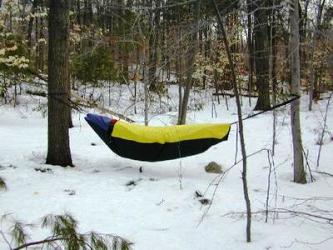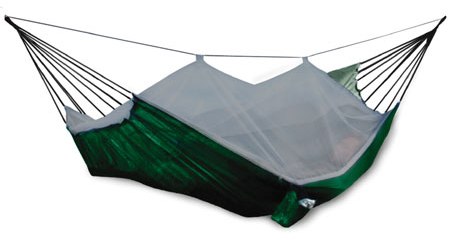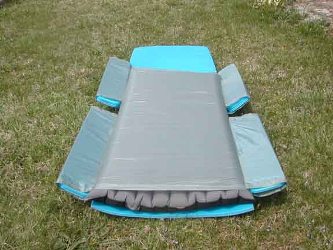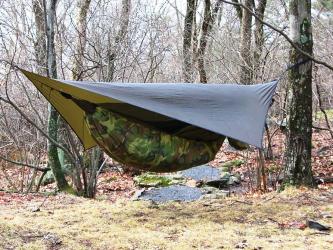Glossary
| Body |
| The main fabric section of the hammock that supports the occupant's weight. Made from various materials including ripstop nylon, silk and polyester taffeta. |
| Bivy (TravelPod, Hammock Sock) | |
| A shell that encompasses the hammock to provide wind or water resistance. See Staying Warm and Staying Dryfor details. | |
Hammock Sock |
 Deb's Hammock Bivy |
| Bug Net |
| Netting that keeps bugs out of the hammock. Can be permanently attached like the Hennessy line of hammocks, or can be removable like Speer hammocks. See Staying Bugfree for more details. |
| Hammock Skins (Hammock Tubes) | |
| See snakeskins |
| PeaPod | |
| An oversized sleeping bag by Speer Hammocks that completely envelops the hammock, providing insulation above and below the hammock. Because the PeaPod does not drape over the body, a top quilt is often required below about 50 F. | |
Speer PeaPod |
| Python Skins | |
| See snakeskins. Python Skins were the JacksRBetter version of snakeskins that were big enough to encompass the hammock and underquilt together. Python Skins are no longer manufactured because Tom Hennessy has a patent pending on Snakeskins. |
| Ridgeline | |
| Two types of ridgelines.
First, the structural ridgeline is very tight, non-stretchy, and sets the amount of sag on the hammock. When you pull the hammock supports tight, you're also pulling the ridgeline tight...but since the ridgeline holds a fixed length, the fabric in the hammock body isn't affected. Tom Hennessy has a patent on this kind of ridgeline so other hammocks can't be sold with it, but you can make your own or add it on to another model with no issues. I like it b/c no matter how you hang your hammock, it always has the same amount of sag. Also, you can tie the supports to the tree at a lower level and still have a comfortable hammock b/c it increases the sag. Next, non-structural ridgelines are just strung up support bugnets or tarps and don't change how the hammock sags. Some of these are elastic and some are cord, occasionally webbing on some homemade ones. Both kinds are good for holding boots, jackets, stuff sacks with nighttime essentials, etc. I always hang my headlamp and emergency whistle up there...that way I can blow the whistle when a bear comes sniffing and never have to leave the hammock. Since I switched to a soft-sided Nalgene I use my water as a pillow, but before that I always had a stuff sack with a snack and bottle of water hung on the ridgeline. Hammock ridgelines are also different from tarp ridgelines. Tarp ridgelines are sometimes just a sewn seam running along the center length that needs to be sealed, and some folks actually run a cord for the full length between the trees and the tarp lays on top of it. Each type has advantages...but as I said, don't confuse tarp ridgelines with hammock ridgelines. |
|
Structural Ridgeline |
No Ridgeline |
 Non-Structural Ridgeline |
|
| Sag | |
| Sag describes how tightly the hammock is strung between the trees. If the hammock is very loose between the trees and adopts a "U" shape, it has a lot of sag. This makes it easier to lay on the diagonal. If the hammock is strung tightly, laying on the diagonal will be more difficult and may cause shoulder squeeze.
Structural ridgelines set a constant amount of sag for the hammock. Hammocks without a structural ridgeline can have a slightly different sag with each hang. |
|
Lots of Sag |
Not Much Sag |
| Segmented Pad Extender (SPE) | |
| A pad sleeve sold by Speer Hammocks that has wings to hold non-compressible insulation against the occupant's shoulders and hips. Without a pad, the hammock will compress the sleeping bag or top quilt at these points, causing cold spots. | |
 The Speer Segmented Pad Extender |
My Homemade SPE |
| Side Tie-Outs | ||
| A feature of Hennessy Hammocks. Elastic lines are attached to the long side of the hammock; these tie-outs are staked to the ground to pull the hammock open. It does not change how the hammock supports the user, but makes it feel more open inside. The elastic also acts as a dampener to reduce the hammock's swing. | ||
Hennessy Side Tie-Out |
Changes the Shape (Photo by Rock) |
Changes the Shape (Photo by Rock) |
| Snakeskins | |
| A product by Hennessy Hammocks. It's a cone-shaped tube that slides over the hammock to make it look like a snake. This makes packing the hammock very easy, and keeps it dry and clean when setting up or taking down the hammock. See Shane Steinkamp's page for details.
Skins can also be used on the tarp for easier storage and easier setup in windy conditions. I like to hang the tarp at night, but leave it in the skins so I can sleep under the stars. If it starts to rain, I can quickly pull back the skins and stake out the tarp. |
|
Python Skins |
|
| Supports | |
| Strap, webbing, cord or rope that connects the hammock to the tree. Because a hammock exerts much more force than simply the occupant's weight, hammock supports should generally be able to hold 600 lbs safely. Cord is generally used with Tree Huggers to avoid damage to the tree, while Polypro straps are wider and disperse the force. | |
Spectra Supports |
Polypro Straps (1" Webbing) |
| Tarp | |
| Rainfly. It keeps you dry. Tarps on hammocks are generally rectangular (8'x10'), a square hung diagonally (8'x8'), or a shaped tarp (catenary cut). See Staying Dry for more details. | |
JRB 8x8 Tarp |
MacCat Catenary Tarp |
| Underquilt | |
| A quilt that attaches to the bottom of the hammock, on the outside so the user does not compress the insulation. Getting a proper fit is essential with an underquilt. JacksRBetter and Kickass Quilts are currently the only two underquilt manufacturers. See Staying Warm for more details. | |
JRB Underquilt on a Hennessy |
 KAQ Potomac on a Hennessy |